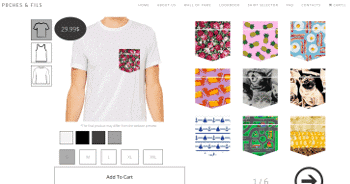
 Montreal eCommerce platform developer Lightspeed has officially launched Lightspeed eCom, a fully integrated omni-channel retail platform that the company believes will accelerate its growth as “the most powerful cloud-based commerce solution for independent businesses, in-store and online.”
Montreal eCommerce platform developer Lightspeed has officially launched Lightspeed eCom, a fully integrated omni-channel retail platform that the company believes will accelerate its growth as “the most powerful cloud-based commerce solution for independent businesses, in-store and online.”
As more and more retailers, both large and small, struggle to survive the shift driven by technological change, integrating online and offline brand presence for consumers, as well as coordinating eCommerce with brick-and-mortar retail and inventory, has become an imperative.
But that integration is easier said than done. For a retailer of any size, integrating front-end and back-end infrastructure, not to mention offline inventory and online eCommerce, remains a challenge with significant barriers to entry, in terms of labour, time and money.
According to Lightspeed’s own research on their client base, 80% of retailers want to integrate their online and physical retail presence.
A report by Retail Systems Research found that 71% of consumers expect to be able to view in-store inventory online, while 50% expect to be able to buy online and pick up in store.
The challenge for retailers rests in that gap between what they know they need to do and what’s within their means, with RSR reporting that more than 60% of retailers believe that having inventory insight, real-time customer visibility and product information across channels is crucial, but also that 40% of them struggle to coordinate in-store operations with their eCommerce.
While Lightspeed is marketing its new eCom platform as a solution aimed at independent businesses that are online-only or online-first, chief revenue officer JP Chauvet makes clear in an interview with Cantech Letter that the platform is very much intended to serve “serious retail”, or companies who would like to become serious retail, selling globally in multiple languages and currencies.
Prior to eCom’s launch, Chauvet says, “Our customers had to make compromises, in a way. If they wanted to have a really good eCommerce platform, that means it would be poorly integrated with the point-of sale or they’d have to go with a point-of-sale that was of lower quality with a very good eCommerce platform. Then the third segment were those that weren’t integrated. And the majority of those that were serious, who really had a very strong online presence and a very strong offline presence, all of those guys had little to no integration between the two platforms. So internally, we call this the ‘no compromise’ launch, where you can actually have the best now of both worlds, fully integrated.”
That “no compromise” approach is illustrated by the experience of Montreal T-shirt company Poche et Fils, whose success and rapid growth exerted pressure to outgrow their previous eCommerce platform.
 Started in January 2015, Poche et Fils began selling about 80 T-shirts a month, mainly through a Facebook page. By the end of 2015, they had earned over $400,000 revenue “only to French Quebeckers”, says co-founder Nicolas Dubeau, with $250,000 of that figure coming in the past two to three months.
Started in January 2015, Poche et Fils began selling about 80 T-shirts a month, mainly through a Facebook page. By the end of 2015, they had earned over $400,000 revenue “only to French Quebeckers”, says co-founder Nicolas Dubeau, with $250,000 of that figure coming in the past two to three months.
With the arrival of Alex Vanier, Poche et Fils’ CTO, the company began using Shopify for eCommerce, only to find that there were limitations that ended up creating extra work that would later be resolved with the adoption of Lightspeed eCom.
“We are French-Canadian. Maybe my accent gives it away,” says Alex. “On Shopify, the back end is only strictly in English. You cannot have another language for it. So that was something that wasn’t really good for us. But right now with Lightspeed, we can set up any language, which is good for us because we are also looking to start selling in Europe, where there’s a lot of different languages. Also, we can now manage different currencies. Those were problems that, once we launch the eCom Lightspeed version of our website, we’ll be able to resolve all those problems.”
And there lies the challenge not only for a retailer experiencing rapid growth, but also for retailers who want to sell their goods internationally, across linguistic, tax and currency jurisdictions.
Aside from solving a retailer’s multi-language, multi-currency, multi-tax jurisdiction problems, Poche et Fils found that Shopify also had trouble handling an essential quirk of their offering, mainly that the company’s product is shirts with unusual detachable pockets, the novelty of which distinguishes them from every other T-shirt company and also presented inventory problems that Shopify couldn’t handle.
“We have an inventory of pockets and an inventory of shirts, but for the client it’s just one,” says Alex. “On Shopify, we weren’t able to track those two separate inventories each time a sale was made. So Nick needed to upload the inventory each night and to manage it with an Excel sheet macro. So that was a big problem that was giving us a lot of work for nothing. Now with Lightspeed eCom, we are now able to track the two inventories separately.”
With Lightspeed eCom allowing retailers to go omni-channel through a single deployment, providing analytics while allowing them to manage complex inventories and sell globally, Lightspeed appears set to take on the world’s eCommerce players on their own terms.
Last June, Lightspeed had a housewarming party at their new Gare Viger headquarters in Montreal.
Although Close Access TV released this video of the event only a week ago, it gives a good idea of the impressive space Lightspeed now inhabits before the company makes its bid for world eCommerce domination.
Leave a Reply
You must be logged in to post a comment.





 Share
Share Tweet
Tweet Share
Share




Comment